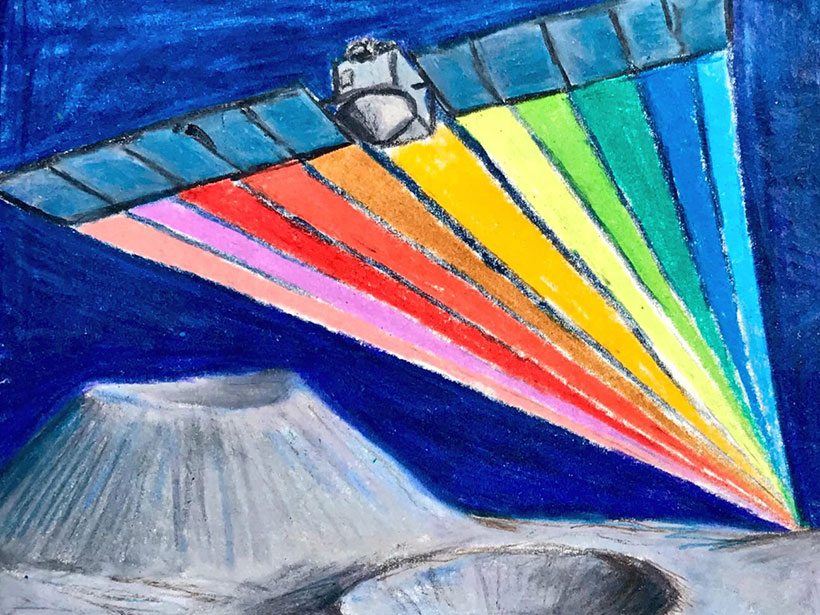Look around during any scientific presentation and you’ll see scientists of all career stages jotting down notes. This is especially true at conferences, where the hundreds or thousands of presentations can become one big blur after a week of sleep deprivation and science.
James Tuttle Keane’s approach to taking notes at conferences is, well, a bit different than most. Keane is a postdoctoral scholar at the Joint Center for Planetary Astronomy at the California Institute of Technology in Pasadena. He’s also a scientific illustrator. During conferences, Keane takes notes by creating elaborate sketches of presentations he attends. He outlines them live during each talk and then details and colors them later.
“I’ve always taken graphical notes because I’m a very visual person and I like to sketch,” Keane said. “They started out as just black-and-white pen sketches. Then I started adding color, and now they’re very detailed and take a lot of time and are very colorful. They’ve evolved and become more artistic.”
In his sketches, Keane tries to capture a few of the key points of a presentation, but from his own point of view. “I want them to have my perspective, my flavor,” he said. “I want them to either show something that wasn’t shown explicitly or say something in a different way.”
Keane started his conference live sketching in 2014, and the science community’s response, he said, has been overwhelmingly positive.
“It’s been exciting to watch this become more of a thing,” he said. “I think that it’s useful to show how you can fold art into science. I think that it’s been beneficial to everyone.”
We first noticed Keane during the 49th Lunar and Planetary Science Conference (LPSC) in Texas earlier this year. All told, he created around 20 different sketches from some of the talks he attended, with topics from Mercury to Pluto and beyond.
Take a tour of the solar system with some of his (and our) favorite illustrations from that conference.
What Does Mercury Look Like Inside? Ask Its Gravity
Antonio Genova—new @PlanetSci @NASAGoddard MESSENGER gravity field of Mercury confirms Mercury is in a Cassini state, and constrains the size of Mercury’s solid inner core. #LPSC2018 pic.twitter.com/kNyFtB9tn3
— James Tuttle Keane (@jtuttlekeane) March 26, 2018
By Grabthar’s Hammer, Go Back to Venus!
This sketch is Keane’s personal favorite from the conference.
Lori Glaze @loriglaze —there so many reasons we need to go back to Venus. In order to get a mission we must NEVER GIVE UP, NEVER SURRENDER. #LPSC2018 #GalaxyGuest #ByGrabtbarsHammer pic.twitter.com/iaHEqFAoHa
— James Tuttle Keane (@jtuttlekeane) March 21, 2018
Our Moon Might Soon Receive Some Visitors from China
Learning about China’s ambitious plans for exploring the Moon at #micro59 #LPSC2018 pic.twitter.com/7FhIGMbct6
— James Tuttle Keane (@jtuttlekeane) March 17, 2018
If You’re Thirsty on Mars, Head Toward the North Pole
Jon Bapst—New thermal models provide insight into the structure of Mars’s polar cap. Only need to go a few meters down to reach pure ice. #LPSC2018 pic.twitter.com/mZ5voJ2dSM
— James Tuttle Keane (@jtuttlekeane) March 20, 2018
Ceres Was Getting Dizzy…
Xiaochen Mao—Ceres’s rotational bulge suggests it once had a spin period of 8.5 hours. Impacts have the potential to slow it down to its present 9 hours. #LPSC2018 pic.twitter.com/pykZtpYwaZ
— James Tuttle Keane (@jtuttlekeane) March 21, 2018
Don’t Forget Europa’s Rocky Center
Andew Dombard—gravity science is critical for understanding the interior structure of Europa (*AMEN*). Long wavelength gravity is dominated by Europa’s rocky mantle. #LPSC2018 pic.twitter.com/Hou9f2CIQU
— James Tuttle Keane (@jtuttlekeane) March 26, 2018
It’s Raining Organics! On Saturn, That Is
Kelly Miller @meteorite_maven —In Cassini’s grand finale, it measured the composition of ring particles raining onto Saturn. Lots lf organics! #LPSC2018 pic.twitter.com/ISFsNegPEB
— James Tuttle Keane (@jtuttlekeane) March 19, 2018
Pluto’s Chaotic Surface Is Really Just an Icy Slip ’n Slide
Sean O’Hara—Pluto’s chaos terrain may be the result of fracturing and sliding of water ice bedrock blocks, permeated and embayed by nitrogen ice. #LPSC2018 pic.twitter.com/kNeDvFfGu9
— James Tuttle Keane (@jtuttlekeane) March 26, 2018
Since LPSC, Keane has been busy explaining the Mars InSight mission and sketching talks at the New Views of the Moon 2–Asia workshop in Japan. Keep an eye out for more of Keane’s work during upcoming conferences and the New Horizons flyby of Ultima Thule on New Year’s Eve 2019.
—Kimberly M. S. Cartier (@AstroKimCartier), Staff Writer
Citation:
Cartier, K. M. S. (2018), Touring the solar system with science art, Eos, 99, https://doi.org/10.1029/2018EO099473. Published on 22 May 2018.
Text © 2018. The authors. CC BY-NC-ND 3.0
Except where otherwise noted, images are subject to copyright. Any reuse without express permission from the copyright owner is prohibited.

